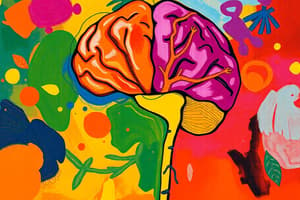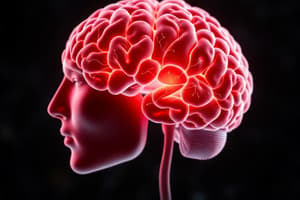Podcast
Questions and Answers
The endocrine system responds more quickly than the nervous system.
The endocrine system responds more quickly than the nervous system.
False (B)
The hypothalamus is the main link between the nervous and endocrine systems.
The hypothalamus is the main link between the nervous and endocrine systems.
True (A)
The pituitary gland is considered the master gland of the endocrine system because it secretes seven hormones.
The pituitary gland is considered the master gland of the endocrine system because it secretes seven hormones.
True (A)
The anterior pituitary accounts for about 50% of the total weight of the pituitary gland.
The anterior pituitary accounts for about 50% of the total weight of the pituitary gland.
The pars intermedia of the pituitary gland remains as a distinct lobe in adults.
The pars intermedia of the pituitary gland remains as a distinct lobe in adults.
Growth hormone is secreted by the anterior pituitary and regulates growth and metabolism.
Growth hormone is secreted by the anterior pituitary and regulates growth and metabolism.
The infundibular stalk connects the pituitary gland to the hypothalamus.
The infundibular stalk connects the pituitary gland to the hypothalamus.
Somatotropic cells in the pituitary gland secrete insulin.
Somatotropic cells in the pituitary gland secrete insulin.
Oxytocin enhances contraction of smooth muscle fibers in the wall of the uterus during delivery.
Oxytocin enhances contraction of smooth muscle fibers in the wall of the uterus during delivery.
In males, oxytocin has well-defined functions related to reproductive health.
In males, oxytocin has well-defined functions related to reproductive health.
The thyroid gland is located just inferior to the diaphragm.
The thyroid gland is located just inferior to the diaphragm.
The normal mass of the thyroid gland is approximately 30 grams.
The normal mass of the thyroid gland is approximately 30 grams.
Antidiuretic hormone (ADH) decreases urine volume production.
Antidiuretic hormone (ADH) decreases urine volume production.
Alcohol consumption increases the secretion of ADH, leading to reduced urine output.
Alcohol consumption increases the secretion of ADH, leading to reduced urine output.
The thyroid gland comprises a single lobe connected by the isthmus.
The thyroid gland comprises a single lobe connected by the isthmus.
Oxytocin is solely responsible for the feelings of sexual pleasure during intercourse.
Oxytocin is solely responsible for the feelings of sexual pleasure during intercourse.
The dehydrating effect of alcohol can cause both thirst and headache typical of a hangover.
The dehydrating effect of alcohol can cause both thirst and headache typical of a hangover.
THYROCYTES are primarily responsible for producing insulin.
THYROCYTES are primarily responsible for producing insulin.
The wall of each follicle consists mainly of cells called T THYROCYTES.
The wall of each follicle consists mainly of cells called T THYROCYTES.
ADH has no effect on water loss through sweating.
ADH has no effect on water loss through sweating.
Inactive T thyrocytes have a low cuboidal to squamous shape.
Inactive T thyrocytes have a low cuboidal to squamous shape.
T3 and T4 are also referred to as thyroid hormones because they contain five atoms of iodine in total.
T3 and T4 are also referred to as thyroid hormones because they contain five atoms of iodine in total.
T thyrocytes promote the formation of ossification centers in developing bones.
T thyrocytes promote the formation of ossification centers in developing bones.
C THYROCYTES produce T3 and T4 hormones.
C THYROCYTES produce T3 and T4 hormones.
Thyrotrophic cells secrete Adrenocorticotropic hormone (ACTH).
Thyrotrophic cells secrete Adrenocorticotropic hormone (ACTH).
Follicle Stimulating Hormone (FSH) is secreted by gonadotrophic cells.
Follicle Stimulating Hormone (FSH) is secreted by gonadotrophic cells.
The posterior pituitary synthesizes hormones instead of storing them.
The posterior pituitary synthesizes hormones instead of storing them.
Prolactin is responsible for initiating milk production in the mammary glands.
Prolactin is responsible for initiating milk production in the mammary glands.
Corticotrophic cells secrete glucocorticoids directly.
Corticotrophic cells secrete glucocorticoids directly.
Melanocyte-stimulating hormone (MSH) is secreted solely by corticotrophic cells.
Melanocyte-stimulating hormone (MSH) is secreted solely by corticotrophic cells.
Oxytocin is responsible for milk ejection and contraction of the uterus.
Oxytocin is responsible for milk ejection and contraction of the uterus.
Antidiuretic hormone (ADH) increases urine production.
Antidiuretic hormone (ADH) increases urine production.
Norepinephrine constitutes approximately 80% of the hormones released by the adrenal medulla.
Norepinephrine constitutes approximately 80% of the hormones released by the adrenal medulla.
The pancreas is solely an endocrine gland.
The pancreas is solely an endocrine gland.
Glucagon is secreted by alpha cells of the pancreatic islets.
Glucagon is secreted by alpha cells of the pancreatic islets.
The pancreatic acini produce hormones that are released into the bloodstream.
The pancreatic acini produce hormones that are released into the bloodstream.
The pancreas measures approximately 12.5–15 cm in length.
The pancreas measures approximately 12.5–15 cm in length.
Epinephrine is secreted by delta cells in the pancreatic islets.
Epinephrine is secreted by delta cells in the pancreatic islets.
The adrenal medulla is innervated by sympathetic postganglionic neurons.
The adrenal medulla is innervated by sympathetic postganglionic neurons.
Somatostatin is secreted by beta cells in the pancreatic islets.
Somatostatin is secreted by beta cells in the pancreatic islets.
Flashcards are hidden until you start studying
Study Notes
The Endocrine System
- The endocrine system utilizes hormones as chemical messengers to regulate various bodily functions.
- The endocrine system often works slower than the nervous system.
- The endocrine system has a wider reach than the nervous system.
- The nervous system and the endocrine system collaborate as an integrated “supersystem.”
Hypothalamus and Pituitary Gland
- Pituitary gland, sometimes referred to as the "master" endocrine gland, secretes crucial hormones controlling other glands.
- The hypothalamus, strategically located below the thalamus in the brain, is the primary link between the nervous and endocrine systems.
- The hypothalamus produces hormones that play roles in growth, development, metabolism, and homeostasis.
Pituitary Gland
- The pituitary gland is a pea-sized structure situated in the sella turcica of the sphenoid bone.
- It comprises two main portions: the anterior and posterior pituitary.
- The infundibular stalk connects the pituitary gland to the hypothalamus.
Anterior Pituitary
- The anterior pituitary, also known as the adenohypophysis, is composed of epithelial tissue and accounts for 75% of the gland's weight.
- The anterior pituitary secretes several hormones that regulate numerous bodily functions, including growth and reproduction.
Hormones Secreted by the Anterior Pituitary
- Growth Hormone (GH), secreted by somatotrophic cells, stimulates general body growth and controls aspects of metabolism.
- Thyroid Stimulating Hormone (TSH), produced by thyrotrophic cells, regulates thyroid gland secretions and activities.
- Folicle-Stimulating Hormone (FSH) and Luteinizing Hormone (LH), secreted by gonadotrophic cells, act on the gonads (testes and ovaries). In men, they promote sperm production and testosterone secretion, while in women, they stimulate oocyte maturation and estrogen and progesterone production.
- Prolactin (PRL), secreted by prolactin cells, initiates milk production in the mammary glands.
- Adrenocorticotropic Hormone (ACTH), secreted by corticotrophic cells, stimulates the suprarenal cortex to secrete glucocorticoids like cortisol.
- Melanocyte-Stimulating Hormone (MSH), also secreted by corticotrophs, plays a role in skin pigmentation.
Posterior Pituitary
- The posterior pituitary, or neurohypophysis, is composed of neural tissue and harbors axons and axon terminals from hypothalamic neurosecretory cells.
Hormones Released from Posterior Pituitary
- The posterior pituitary does not synthesize hormones but instead stores and releases two hormones from the hypothalamus:
- Oxytocin (OT): This hormone stimulates uterine contractions during labor and milk ejection.
- Also plays a role in feelings of sexual pleasure.
- Antidiuretic Hormone (ADH)/Vasopressin: This hormone reduces urine production by promoting water retention.
- Alcohol inhibits ADH secretion, leading to increased urination.
- ADH also regulates blood pressure.
- Oxytocin (OT): This hormone stimulates uterine contractions during labor and milk ejection.
Thyroid Gland
- The thyroid gland, butterfly-shaped and located below the larynx, is composed of right and left lobes connected by an isthmus.
- Microscopic spherical sacs called thyroid follicles, composed of follicular cells (T thyrocytes), make up the thyroid gland.
Thyroid Hormone Production
- Follicular cells produce two hormones:
- Thyroxine (T4): Contains four iodine atoms.
- Triiodothyronine (T3): Contains three iodine atoms.
Functions of Thyroid Hormones
- The thyroid hormones (T3 and T4) regulate:
- Metabolism
- Growth and Development
- Body temperature regulation
- T3 and T4 increase metabolism, heart rate, and blood pressure.
- They also play crucial roles in nervous system development and bone growth.
Suprarenal Medulla
- The suprarenal medulla, a modified sympathetic ganglion, is located within the suprarenal gland.
- This region produces hormones that intensify sympathetic responses.
Hormones Secreted by the Suprarenal Medulla
- Chromaffin cells in the suprarenal medulla secrete:
- Norepinephrine/adrenaline/noradrenaline: 80%
- Epinephrine: 20%
Pancreas
- The pancreas functions as both an endocrine and exocrine gland.
- It is a flattened organ situated in the curve of the duodenum.
Exocrine Function of the Pancreas
- Pancreatic acini, clusters of exocrine cells, constitute 99% of the pancreas.
- They produce digestive enzymes that reach the digestive canal through a network of ducts.
Endocrine Function of the Pancreas
- Pancreatic islets/Islets of Langerhans, about 1-2 million small clusters of endocrine cells, are scattered among the pancreatic acini.
- Pancreatic Islets contain four types of hormone-secreting cells:
- Alpha (A) cells (17%): Secrete glucagon.
- Beta (B) cells (70%): Secrete insulin.
- Delta (D) cells (7%): Secrete somatostatin.
- F cells (very low percentage): Secrete pancreatic polypeptide.
Studying That Suits You
Use AI to generate personalized quizzes and flashcards to suit your learning preferences.




